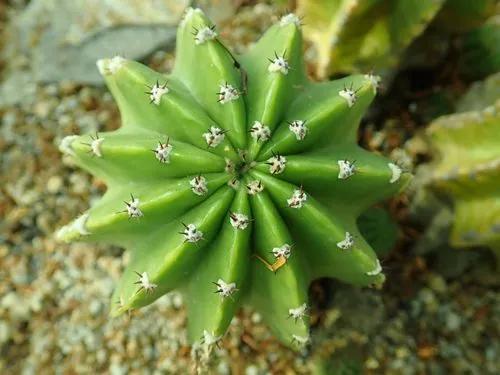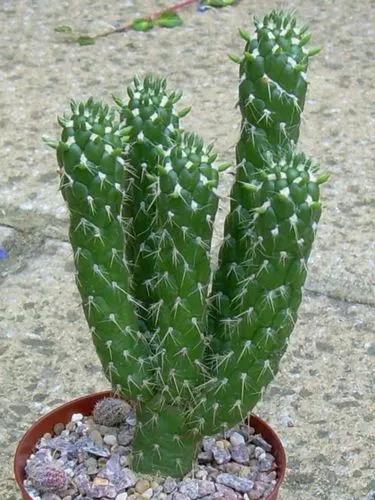Orbea dummeri is an unusual and curiously attractive member of the greater Milkweed Family (Asclepiadoideae) with clustering mounds of succulent stems. Plants typically grow to about 4 inches in height, and will eventually spread to form low mats to a foot or more wide. Stems are branching, with long, pointed tubercles in two ranks. Typically, the stems have a pale grey/green coloration and are heavily marked with reddish purple dots, splotches and lines; but in very bright sunlight, the base color becomes more pale, to almost white with just a hint of green. These are typically summer bloomers, producing smallish starfish-shaped flowers high on the stems. On my plants, the flowers open to just under an inch across, but there is some variation in the size of flowers from plant to plant, and some plants may produce flowers to 2 inches across. Color varies from olive green, to nearly chartreuse, but in some online images, the flowers appear to be nearly yellow. The petals bear many papillae, each one topped with a stout, translucent/white hair. The corolla is nearly white, and includes the pollinia, and stigma.
Stapelia Dummeri Care
Orbea Dummeri



How to Care for the Plant

Water

Very little water

Fertilizer

They also enjoy some fertiliser.

Sunlight

It needs as much light as possible, but protect from direct sun during summer.

Soil

Since roots are quite shallow, use a cactus mix or add extra perlite or pumice to regular soil potting soil. A gritty, very free-draining compost is suitable, and clay pots help the plants to dry out between watering.

Temperature

It will tolerate normal temperatures in summer and can be put outdoors until early autumn. In winter keep at a minimum temperature of 10°C (50°F).

Additional

The Turkana people in Kenya drink a decoction of the stems with milk or chew the stems to treat chest pains. Fresh plant sap is squeezed on wounds to heal them. In Uganda the dried and powdered whole plants are put in water and the filtrate is put in the ear to help evacuate ear wax and to treat headache. In Tanzania the latex is applied as ear drops to treat earache.

Popularity

268 people already have this plant 79 people have added this plant to their wishlists
Discover more plants with the list below
Popular articles






